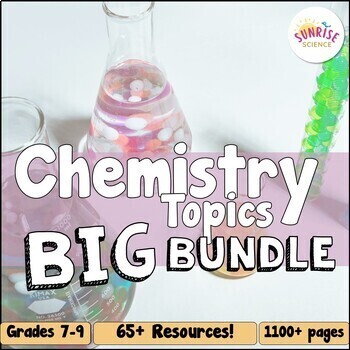Chemistry Middle School Science Curriculum Properties of Matter Atoms Reactions
- Zip
- Easel Activity
What educators are saying
Products in this Bundle (68)
showing 1-5 of 68 products
Bonus
Description
This is a bundle of all of my resources for teaching chemistry concepts at the 8th / 9th grade level, including laboratory equipment and safety, states, properties and changes in matter, atoms and the periodic table, and bonding and chemical reactions. These resources include a mix of Cornell Doodle Notes, labs, demonstrations, practice activities, manipulatives, projects, and assessments. As I add any new resources related to these topics, they will be added to this bundle as well!
Receive a HUGE discount with this BIG bundle of over 65 chemistry resources! These are the topics that are covered by the products in this bundle:
- Common Laboratory Equipment
- Laboratory Safety
- The Metric System & Metric Conversions
- Measuring Matter (length, volume, mass, weight)
- Claim-Evidence-Reasoning
- Experimental Design
- Elements, Compounds, and Mixtures
- Physical and Chemical Properties of Matter
- Density of Solids and Liquids
- States of Matter
- Phase Changes
- Physical and Chemical Changes of Matter
- Heat Transfer / Thermal Energy
- Energy of Matter
- Thermal Expansion
- Endothermic versus Exothermic Processes
- Chemical Energy / Calories
- Gas Laws and Behavior
- Scientific Theory vs. Law
- Atomic Theory
- Atomic Structure
- Reading the Periodic Table
- Properties of Metals, Nonmetals, and Metalloids
- Modeling Atoms (Bohr and Lewis Dot Diagrams)
- Isotopes
- Element Research Project
- Element Families
- Periodic Patterns in Atomic Structure
- Design Your Own Periodic Table Project
- Counting Atoms in Chemical Formulas
- Covalent Bonding
- Ions- Cations and Anions
- Ionic Bonding
- Electronegativity
- Balancing Chemical Equations
- Conservation of Mass
- Types of Chemical Reactions
- Controlling Chemical Reactions
- Chemistry of Smell and Molecular Compounds
I have included an editable pacing guide to help with planning the scope and sequence of the activities included in the bundle.
- ✨ GROWING BUNDLE! As I add any new resources related to chemistry, they will be added to this bundle as well (and you will receive them for FREE).
- In addition to the resources included, your download includes many BONUS resources that include additional activities, mini-lessons, and mini-labs.
- Please note that the topic of Nuclear Chemistry is not included in this bundle, but all of my Nuclear Chemistry resources can be found HERE.
If you teach these topics plus physics topics, you may be interested in my EVEN BIGGER Physical Science BIG Bundle!
Thanks for looking!
Sunrise Science





